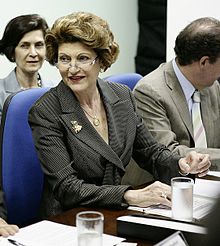Administration

The Commission is divided into departments known as Directorates-General (DGs) that can be likened to departments or ministries. Each covers a specific policy area such as agriculture or justice and citizens' rights or internal services such as human resources and translation and is headed by a director-general who is responsible to a commissioner. A commissioner's portfolio can be supported by numerous DGs; they prepare proposals for them and if approved by a majority of commissioners proposals go forward to the Parliament and Council for consideration. The Commission's civil service is headed by a Secretary General. The position is currently held by Ilze Juhansone. The rules of procedure of the European Commission set out the Commission's operation and organisation.
There has been criticism from a number of people that the highly fragmented DG structure wastes a considerable amount of time in turf wars as the different departments and Commissioners compete with each other. Furthermore, the DGs can exercise considerable control over a Commissioner with the Commissioner having little time to learn to assert control over their staff.
According to figures published by the Commission, 23,803 persons were employed by the Commission as officials and temporary agents in September 2012. In addition to these, 9230 "external staff" (e.g. Contractual agents, detached national experts, young experts, trainees etc.) were employed. The single largest DG is the Directorate-General for Translation, with a 2309-strong staff, while the largest group by nationality is Belgian (18.7%), probably due to a majority (17,664) of staff being based in the country.
Pressedit
Communication with the press is handled by the Directorate-General Communication. The Commission's chief spokesperson is Pia Ahrenkilde Hansen who takes the midday press briefings, commonly known as the "Midday Presser". It takes place every weekday in the Commission's press room at the Berlaymont where journalists may ask questions of Commission officials on any topic and legitimately expect to get an "on the record" answer for live TV. Such a situation is unique in the world.
It has been noted by one researcher that the press releases issued by the Commission are uniquely political. A release often goes through several stages of drafting which emphasises the role of the Commission and is used "for justifying the EU and the commission" increasing their length and complexity. Where there are multiple departments involved a press release can also be a source of competition between areas of the Commission and Commissioners themselves. This also leads to an unusually high number of press releases, 1907 for 2006, and is seen as a unique product of the EU's political set-up. The number of Commission press releases shows a decreasing trend. 1768 press releases were published in 2010 and 1589 in 2011.
There is a larger press corps in Brussels than Washington, D.C.; in 2007, media outlets in every Union member-state had a Brussels correspondent. However, following the global downturn, the press corps in Brussels shrunk by a third by 2010. There is one journalist covering EU news for Latvia and none for Lithuania. Although there has been a worldwide cut in journalists, the considerable press releases and operations such as Europe by Satellite and EuroparlTV leads many news organisations to believe they can cover the EU from these source and news agencies. In the face of high-level criticism, the Commission shut down Presseurop on 20 December 2013.
Comments
Post a Comment